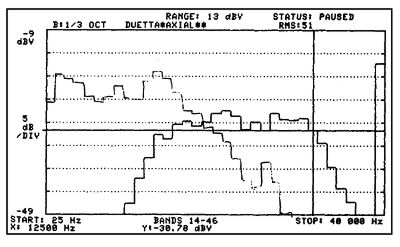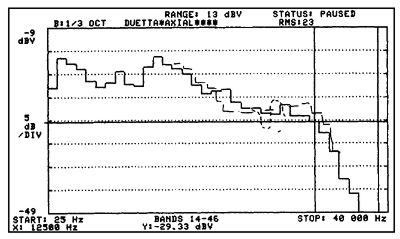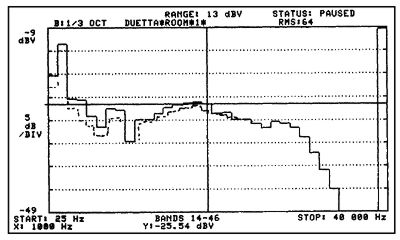The Duetta's low-frequency driver is necessarily subject to some resonance modes and, in addition, suffers from some acoustic obstruction due to the perforated steel-plate baffle used to support the massive array of planar magnets. These provide the distributed magnetic field associated with the zigzag current flow of the diaphragm conductor pattern. The acoustic "window area" of the bass section is not very high, though if this were increased, panel rigidity would suffer. The bass driver, having a one-sided magnetic field, is driven in single-ended rather than the preferred push-pull mode. In theory, this would predict higher distortion levels, but in practice, the distortion from such a large radiating area is quite negligible, even at realistically high sound-pressure levels.
Due to their large area, the Duetta diaphragms radiate heat well, providing a high power handling which is necessary in view of the low sensitivity. A particular feature of the Apogee drive system is its very high inherent linearity, resulting in a freedom from the compression effects apparent in many moving-coil systems, as well as in some electrostatics when the peak handling limits are exceeded.
Sound Quality
I shall leave the more effusively indulgent characteristics of sound quality to my American colleagues and present (I hope!) a rather more academically objective view.
This speaker has improved considerably since my first acquaintance with the original samples some 15 months ago, which I declined to review. In my system, problems were experienced with tonal imbalance, midrange glare, and a lack of precision in the high treble, though other critics seem to have enjoyed greater success with its sound.
With the Mk.II, I found a greatly improved uniformity of frequency response, and the high-treble problem was avoided. The speaker was easy and relaxing to live with, and had great virtues. However, there was also what I feel to be a considerable flaw: the Duetta was demonstrably and unarguably rich in balance, and sounded dim when set against my established references, all of which have been directly compared with live sound sources under controlled conditions. If the Duetta is the only speaker you use, or perhaps the only speaker used that day, and you only play your brightest-sounding records, then you may become accustomed to its tonal balance. In my 80m3 room, the bass was almost overpowering in level, while the balance sounded as if downtilted with increasing frequency all the way from 50Hz to 10kHz. (Imagine a Quad 34 or 44 tilt control rotated fully for the richest tonal balance.) I felt a strong urge to beg, steal, or borrow the nearest Cello Palette and attempt some moderation of this speaker's slow, ponderous balance.
In addition, while the problem I had perceived above 12kHz from the Mk.I had gone, so, it appeared, had the extreme treble itself! The treble sounded filtered, with little air or sparkle in the final audio octave. The end result was still very sweet, but lacked a sufficiently "open" quality. Perhaps surprisingly, however, the Duetta sounded best with the treble switch up (ie, dimmer). With the switch set down, the treble was lifted slightly at the expense of a mild return of upper-mid "glare," something I can do without. I also indulged in some strictly illegal fiddling: I tried placing 1.5-ohm resistors (25 watt wirewound) in series with the woofer panels, which helped the tonal balance somewhat.
The Duettas are amazingly insensitive; for example, Audio Research M100s (on their 4-ohm taps) sounded wonderful at low levels, but failed to stir the Duetta into life at high levels. Substitution of Krell KMA-100s (lovely amplifiers these, despite their being solid-state) essentially maintained the standard of reproduction but added some 6dB of level, bringing the Duettas to a satisfactory volume level.
A quick lab check showed that the KMA-100 could churn out 200 watts into 8 ohms, and 360W into 4, yet to obtain the full dynamic range I believe the Duetta capable of, I felt the need for a KMA-200 or the equivalent. In room, this would establish maximum sound levels of typically 105dBA from a stereo pair. For reference, a KEF R107 fed a standard 100W (8 ohms) per channel will deliver 107dBA. An MGIIIa fed its power limit of 100W (8 ohms) would deliver a satisfactory 101dBA.
With its rich balance, the Duetta needed heavy driving to bring up the mid and treble ranges subjectively, whereupon the magic qualities of this fundamentally musical transducer were then revealed. Most of the frequency range was of high purity with excellent transparency, and once you had become adapted to this speaker tonally, it rewarded you with an excellent focus, fine orchestral perspectives, and big soundstages. The usable treble range was dulled, but otherwise of very fine quality. Leaving aside the question of balance, the bass was exceptionally good, appearing powerful, clean, articulate, and extended, virtually to the subwoofer level (footnote 1). But most importantly, the midrange was very good indeed, and worthy of both the brandname and the asking price.
Coloration (in the resonance sense) was very low, the sound imbued with a great sense of ease. The Duettas were not immediately lively, in a dynamic sense, but did continue to impress with their high resolution of inner detail, as well as by their discrimination of subtle harmonic shadings.
Conclusion
Given a near-unlimited amplifier budget, my ultimate sympathies lie with the Duetta II. As a reviewer, however, I could not cope with it in its present state. It is simply too rich, tonally, too insensitive to use as a reviewing tool; if intended as the basis for a music room . . . well, that would be another matter! If the diminished final octave does not matter too much, and if really high sound levels are not required, and if a large room is also available (quite a few "ifs"!), then the Duetta is the best choice. There is no doubt that its intrinsic quality was in the highest class, and implied no limit in terms of the matching amplifier quality; the Audio Research M100 proved this, though it didn't achieve a sensible volume level.
I would ask Apogee to consider an approved modification for bypassing the crossover. Krell's Dan D'Agostino could then work up a nice equalized electronic crossover, working in conjunction with a pair of KSA-100s, to provide direct-coupled, biamped operation. I confidently predict that this combination would provide one of the finest performances for the money presently available in the business (footnote 2).
I have outlined the major characteristics of these speakers; now it's up to you!—Martin Colloms
Footnote 1: In larger rooms—200m3—the bass was proportionately reduced, and much better balanced.—Martin CollomsFootnote 2: Provisions have been made for the Duetta Series II to be driven via an active crossover. Owners should consult the Manual for instructions.—John Atkinson



 We got off to a bad start with the Duettas. Ricardo Franassovici, of UK importer Absolute Sounds, thoughtfully decided to help me unpack and set them up, but on doing so discovered that the screws for mounting the rear of the baseplate were missing. impatient to hear what they sounded like, he stood them up on their vestigial fixed stands, and the inevitable happened: one of them keeled over, taking a bite out of a windowsill and doing some internal damage to the frame of the speaker in the process. They nevertheless continued to work.
We got off to a bad start with the Duettas. Ricardo Franassovici, of UK importer Absolute Sounds, thoughtfully decided to help me unpack and set them up, but on doing so discovered that the screws for mounting the rear of the baseplate were missing. impatient to hear what they sounded like, he stood them up on their vestigial fixed stands, and the inevitable happened: one of them keeled over, taking a bite out of a windowsill and doing some internal damage to the frame of the speaker in the process. They nevertheless continued to work.


